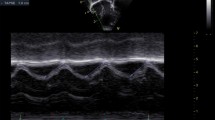Abstract
Sudden death is a possible occurrence for newborns younger than 1 year with severe aortic coarctation (CoA) before surgical correction. Basic research and animal experiments have shown electrophysiologic changes during mechanical ventricular pressure overload. The current study aimed to evaluate the effect of severe CoA on the heterogeneity of ventricular repolarization by examining corrected QT and JT interval dispersion (respectively, QTc-D and JTc-D) and electrocardiographic parameters of spatial heterogeneity of ventricular repolarization in newborns with no associated congenital cardiac malformations. The study enrolled 30 isolated severe CoA neonates (age, 45 ± 15 days; 17 males) with normal size and wall thickness of the left ventricle before surgical correction and 30 age- and sex-matched healthy newborns used as control subjects. Heart rate, QRS duration, maximum and minimum QT and JT intervals, and QTc-D and JTc-D measurements were performed. The healthy control group did not significantly differ from the CoA group in terms of heart rate, weight, height, and echocardiographic parameters. Compared with the healthy control group, the CoA group presented significantly increased values of QTc-D (109.7 ± 43.4 vs. 23 ± 15 ms; P = 0.03) and JTc-D (99.1 ± 43.3 vs. 65.8 ± 24.1 ms; P = 0.04). A statistically significant correlation was found between the Doppler peak pressure gradient across the coarctation site and the values of QTc-D (r = 0.48; P = 0.03) and JTc-D (r = 0.42; P = 0.04). Our study showed significantly increased QTc-D and JTc-D in isolated CoA newborns with normal left ventricular geometry.
Similar content being viewed by others
References
Ahnve S (1985) Correction of the QT interval for heart rate: review of different formulas and the use of Bazett’s formula in myocardial infarction. Am Heart J 109:568–574
Barr CS, Nass A, Freeman M, Lang CC, Struthers AD (1994) QT dispersion and sudden unexpected death in chronic heart failure. Lancet 343:327–329
Bazett HC (1920) An analysis of the time relations of electrocardiograms. Heart 7:353–370
Buja G, Miorelli M, Turrini P, Melacini P, Nava A (1993) Comparison of QT dispersion in hypertrophic cardiomyopathy between patients with and without ventricular arrhythmias and sudden death. Am J Cardiol 72:973–976
de Bruyne MC, Hoes AW, Kors JA, Hofman A, van Bemmel JH, Grobbee DE (1998) QTc dispersion predicts cardiac mortality in the elderly. The Rotterdam Study. Circulation 97:467–472
Dean J, Lab MJ (1989) The effect of changes in load on the monophasic action potential of the in situ pig heart. Cardiovasc Res 23:887–896
Devereux RB, Alonso RD, Lutas EM et al (1986) Echocardiographic assessment of left ventricular ipertrophy: comparison to necropsy finding. Am J Cardiol 57:450–458
First T, Skovránek J, Marek J, Tax P, Hucín B (1990) Echocardiographic diagnosis of aortic coarctation in neonates and infants. Cesk Pediatr 45:265–268
Franz MR, Burkhoff D, Yue DT, Sagawa K (1989) Mechanically induced action potential changes and arrhythmia in isolated and in situ canine hearts. Cardiovasc Res 23:213–223
Fuller MS, Sandor G, Punske P, Taccardi B, MacLeod RS, Ershler PR et al (2000) Estimates of repolarization dispersion from electrocardiographic measurements. Circulation 102:685–691
Higham PD, Furniss SS, Campbell RW (1995) QT dispersion and components of the QT interval in ischaemia and infarction. Br Heart J 73:32–36
Khatib SY, Lab MJ (1982) Differences in electrical activity in the apex and base of left ventricle produced by changes in mechanical conditions of contraction. J Physiol Lond 324:25–26
Kuo CS, Munakata K, Reddy CP, Surawicz B (1983) Characteristics and possible mechanism of ventricular arrhythmia dependent on the dispersion of action potential durations. Circulation 67:1356–1367
Kuo CS, Munakata K, Reddy CP, Surawicz B (1985) Mechanism of ventricular arrhythmias caused by increased dispersion of repolarization. Eur Heart J 6(Suppl D):63–70
Lab MJ (1978) Mechanically dependent changes in action potentials recorded from the intact frog ventricle. Circ Res 45:519–528
Lab MJ (1980) Transient depolarisation and action potential alterations following mechanical changes in isolated myocardium. Cardiovasc Res 14:624–637
Lepeschkin E, Surawicz B (1952) The measurements of the QT interval of the electrocardiogram. Circulation 6:338–378
Lerman BB, Burkhoff D, Yue DT, Franz MR, Sagawa K (1985) Mechanoelectrical feedback: independent role of preload and contractility in modulation of canine ventricular excitability. J Clin Invest 76:1843–1850
Merx W, Yoon MS, Han J (1977) The role of local disparity in conduction and recovery time on ventricular vulnerability to fibrillation. Am Heart J 94:603–610
Paventi S, Bevilacqua U, Parafati MA, Di Luzio E, Rossi F, Pelliccioni PR (1999) QT dispersion and early arrhythmic risk during acute myocardial infarction. Angiology 50:209–215
Picard MH, Adams D, Bierig SM et al (2011) American Society of Echocardiography recommendations for quality echocardiography laboratory operations. J Am Soc Echocardiogr 24:1–10
Rao PS (1995) Should balloon angioplasty be used instead of surgery for native aortic coarctation? Br Heart J 74:578–579
Råsten-Almqvist P, Rajs J (2004) Cardiovascular malformations and sudden death in infancy. Am J Forensic Med Pathol 25:134–140
Russo V, Rago A, Pannone B et al (2011) Dispersion of repolarization and beta talassemia major: the prognostic role of QT and JT dispersion for identifyng the high risk patients for sudden death. Eur J Haematol 86:324–331
Sideris DA, Chrysos DN, Maliaras GK, Michalis LK, Moulopoulos SD (1988) Effect of acute hypertension on the cardiac rhythm: experimental observation. J Electrocardiol 21:183–191
Sideris DA, Toumanidis ST, Kostis EB, Diakos A, Moulopoulas SD (1989) Arrhythmogenic effect of high blood pressure: some observations on its mechanism. Cardiovasc Res 23:983–992
Vassallo JA, Cassidy DM, Kindwall KE, Marchlinski FE, Josephson ME (1988) Nonuniform recovery of excitability in the left ventricle. Circulation 78:1365–1372
Zabel M, Portnoy S, Franz MR (1995) Electrocardiographic indexes of dispersion of ventricular repolarization: an isolated heart validation study. J Am Coll Cardiol 25:746–752
Author information
Authors and Affiliations
Corresponding author
Rights and permissions
About this article
Cite this article
Nigro, G., Russo, V., Rago, A. et al. Heterogeneity of Ventricular Repolarization in Newborns With Severe Aortic Coarctation. Pediatr Cardiol 33, 302–306 (2012). https://doi.org/10.1007/s00246-011-0132-4
Received:
Accepted:
Published:
Issue Date:
DOI: https://doi.org/10.1007/s00246-011-0132-4




